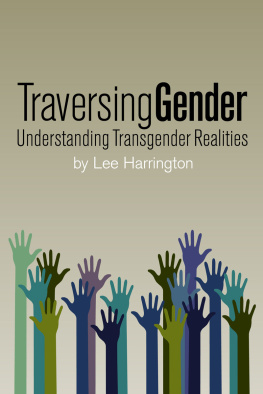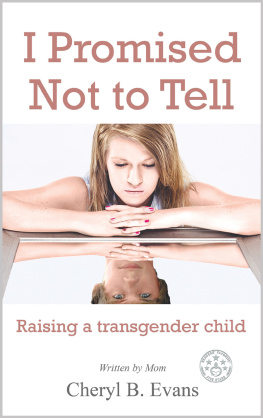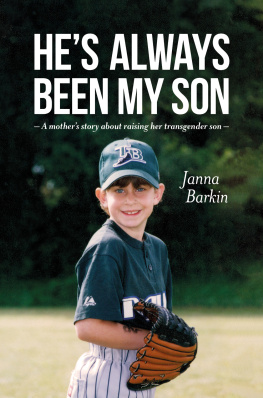EDITORS NOTE
T his book is written from a mothers perspective. In staying true to the story as it unfolded, we felt it was important to use gender pronouns reflecting Peggys experience at the time, rather than the reality of Jakes essential male identity. I hope readers will understand and accommodate the reason for this unusual usage.
This is something Peggy experiences on a daily basis. Her memories are like a split screen. When thinking about Jake before the transition, the automatic memories are of him as Julia. After the transition they are of Jake. This is reflected in the book by the flexible use of pronouns, depending on the chronology of the story.
I think a lot of parents in my shoes would agree. You cannot erase the years of memory or replace them. They are written in our brains and we see it that way. I honor my child, but I also have to honor my memories.
Peggy Cryden, LMFT
PREFACE
I first met Peggy Cryden 12 years ago when I was invited to join a womens poker group hosted by a mutual friend. Peggy was one of three women in the group who had changed careers mid-life to become marriage and family therapists. The group also included two psychologists, and a few other women who worked in different fields. I was at a time in my life when my enthusiasm for the job Id been doing in the entertainment business for the past 15 years was waning. Psychology had always been an interest and I have these women to thank for influencing me to go back to school and pursue a career in counseling.
The poker games were hosted by different members and were held every three or four weeks. During the games held at Peggys house I had the opportunity to get to know her family. They seemed warm and friendly, and also like a pretty normal middle-class Jewish family living in Los Angeles. Peggys daughter Julia would always come over to the table to say hello and chat for a few minutes. She seemed like an affable teenager, outgoing and enthusiastic about life. Julia was a musician who played the drums in a band. A couple of us went to see her perform at a club and were impressed by her talent. She had a tomboyish, punk rocker sort of look. I later learned that Julia was a lesbian. Peggy was completely accepting of that fact and supported her daughter whole-heartedly. We all let Julia into our hearts and in some cases, our homes, as she baby-sat for a few of our children. Little did we know what was actually going on with this very likable teenage girl.
At one of the poker games Peggy hosted a year or so later, a couple of us noticed a change in Julias appearance. She was dressed like a boy, with her hair cut in a more masculine style. Her voice seemed lower. I noticed that she seemed to be growing sideburns. I saw the other women in the group nervously glancing around, also wondering what was going on with Peggys daughter. A few days later I asked the organizer about Julia. She was one of Peggys closest friends and told me that Julia was transgender, taking hormones, and about to have surgery. Word must have gotten back to Peggy and, at the next game, she explained the situation to all of us. We learned that Julia had felt she was supposed to be a boy from the time she was three. As a teenager, she had been struggling to find her identity. At first, she believed she was a lesbian, but that didnt feel right. What Julia wanted was to be a man.
When Julia started having suicidal thoughts, Peggy got her into a program at Childrens Hospital in Los Angeles for transgender youth. After two years of attending various modes of therapy, a physician had finally given the okay for Julia to go ahead with gender affirming surgery. At this very moment, Julia was in the process of becoming Jake. We were all moved by Peggys open-minded attitude and complete support of her oldest child.
But Peggys story is not only about raising a transgender child. During the time she was dealing with her teenagers gender identity crisis, Peggy was also struggling with her own identity issues. During a wine tasting party we both attended, I learned that she had been adopted as a baby and had recently concluded a long search for her birth mother, which resulted in their reunification after 46 years. Later, after Peggy and I became hiking buddies, she confided that she had faced many difficult challenges while being raised by her adoptive parents. In addition, I learned that her younger child Jay had been struggling with an eating disorder and obsessive compulsive disorder (OCD) since he was 14 years old. Yet Peggys story is not all heartache. Despite everything she has experienced, she is an extremely warm, humorous, intelligent woman with an infectious zest for life. Moreover, the journey Peggy has been on so far has helped her form her parenting skills and her own unique philosophy of life, which is summed up in her family mottoIt is what it is.
During one of our hikes in the canyon, Peggy told me she wanted to write a book about herself and her family, chronicling the obstacles they had all faced and overcome on their path to healing, and what she had learned in the process. She confided that she had struggled most of her life with attention deficit hyperactivity disorder (ADHD), and didnt think she could write the memoir on her own. I had a background in writing and editing, and had the goal of writing a book myself related to my new field. All I needed was a good topic, and here was one being handed to me on a silver platter. I proposed to Peggy that we write the book together and she leapt at the idea.
This book is an opportunity for Peggy to tell her fascinating story. It is also an opportunity to educate the reader about gender dysphoria, a psychological diagnosis that affects 0.3 percent of the population, though this number is potentially higher due to the proportion of people who are reluctant to disclose their gender identity. Life can be agonizing for those who feel they were born in the wrong body, which coincidentally is the name of the MSNBC documentary that featured Jake. Peggy, Jake, and Jay have also appeared several times on The Oprah Winfrey Show . Their story is unusual in that it has a happy ending.
This is a tale many parents can relate to, about having children who did not turn out the way they had imagined or hoped. Peggys story encourages us to be open-minded about our childrens choices and needs, and to be loving and supportive even if those choices and needs are difficult for us to digest. However, this does not mean we should support choices that will endanger our children or cause them to get in trouble with the law. Peggys decisions regarding her childrens welfare were not made lightly. They were made after much research, much discussion, much consultation, and many hours of therapy, and they were decisions that saved both her sons lives and kept the family from disintegrating. Peggys journey will help educate the reader about the transgender experience and other LGBTQ issues, is meaningful for parents, and gives much food for thought about identity, sprinkled throughout with her humorous contemplations about the human condition.
Janet E. Goldstein-Ball, LMFT
Gates, G.J. (2011) How Many People Are Lesbian, Gay, Bisexual, and Transgender? Los Angeles, CA: Williams Institute, UCLA School of Law.











